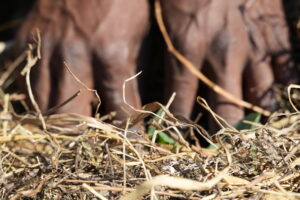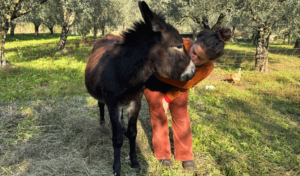TEKU CANA
Teku cana, or “life in motion” in the language of the Mixtecs, an indigenous Mesoamerican people residing in the Mexican state of Oaxaca, is a preparation intended to multiply indigenous microorganisms to be used later as bio-fertilizer.
On May 29th, we made it here at Radici during an afternoon group work session in the garden. Here are the ingredients we used for a 200-liter barrel:
- 80 kg of bran;
- 40 kg of indigenous forest litter (the closer, the better);
- 14 kg of cane molasses;
- 2 kg of micronized zeolite;
- Water as needed.
On a plastic sheet, we began to mix all the ingredients, progressively adding water until reaching the desired humidity, which can be checked with the fist test: take a handful of the product and squeeze it, there should be at most 1 or 2 drops.

We then started to put the mixture into the 200-liter barrel (clean, food-grade, and airtight) while one person at a time, situated inside the barrel, meticulously pressed it to avoid leaving any air. This is, in fact, an anaerobic preparation. About 20 cm of space is left between the surface of the mixture and the lid, and it is sealed hermetically. The microorganisms initially reproduce upon contact with the air, but once the air runs out, they will spiral and go into dormancy.
The ideal temperature is about 20°C, so we left the barrel in the shade under an olive tree, where it will remain for a period ranging from 30 to 45 days. When the barrel lid deflates, the teku cana is ready.

Once ready, it can be used in various ways, both solid and liquid, as soil and foliar fertilizer, to improve bocashi, as bedding, and as animal feed. It can be used as an inoculant for a new preparation and, after being reproduced three times in this way, it can be given as feed to animals.
The purpose of Teku cana is to enrich our agricultural systems with beneficial microorganisms that will make nutrients more easily assimilable by plants, as well as occupy every possible ecological niche that would otherwise risk being taken over by fungi and pathogens. It is also valuable for speeding up the decomposition of organic matter such as wood chips, straw, hay, etc.
And most importantly… making it is super fun and a wonderful group activity!


